Guided by Lore: The role of Kinship and Totemic Dreaming in Indigenous Systems of Healing
By Sheridan Teitzel - 2024 Monica Clare Research Fellow | 21 March 2025
Guest blogger: Sheridan Teitzel - 2024 Monica Clare Research Fellow.
Project: Sacred plants and cultural frameworks: Capturing first nations value systems in western Cape York.
Project Contributors: Richard Barkley, Fiona Wirrer-George, Constance Bandicootcha, Richard Ornyengia, Marie Kalkiyorta, Lyall Kawangka, and Dorothy Pootchemunka.
Community Review: Richard Barkley, Fiona Wirrer-George, Constance Bandicootcha
I began my dedicated journey of learning traditional methods of plant medicine in 2021 under the guidance of my big uncle, Kukoo Richard Barkley (Thainakwith). My curiosity was sparked by my growing interest of the role of kinship systems in healing and how our practices extend beyond people to encompass the environment. Since commencing this fellowship in 2024, I have had the privilege of working alongside a number of elders and community leaders in addition to my work with Kukoo Richard. These include song woman -Nanny Marie Kalkiyorta (Puutch), elder - Sisi Dorothy Pootchemunka (Winchanum/Aplach), senior family members - Uncle Richard Oryengaia (Wik-Way/Wanam), Uncle Lyall Kawangka (Winchanum) and Mum Constance Bandicootcha (Puutch), as well as my mother, Fiona Wirrer-George (Wik-Way/Alngith-Liningithi), who is the first person of blood lineage connection to the Wik & Wik-Way to obtain an academic PhD.
The process of capturing their knowledge has been incredible, and in many ways, a process of self-discovery and reconnection. Living in a community rich in cultural knowledge, I have always turned directly to my family and elders for guidance. However, this fellowship required me to take a dual approach, incorporating both oral teachings and structured research. Throughout the literature review, I gained a deeper appreciation for the works of Elizabeth Edwards, Peter Sutton, and Ursula McConnel, whose insights feature prominently in my findings.
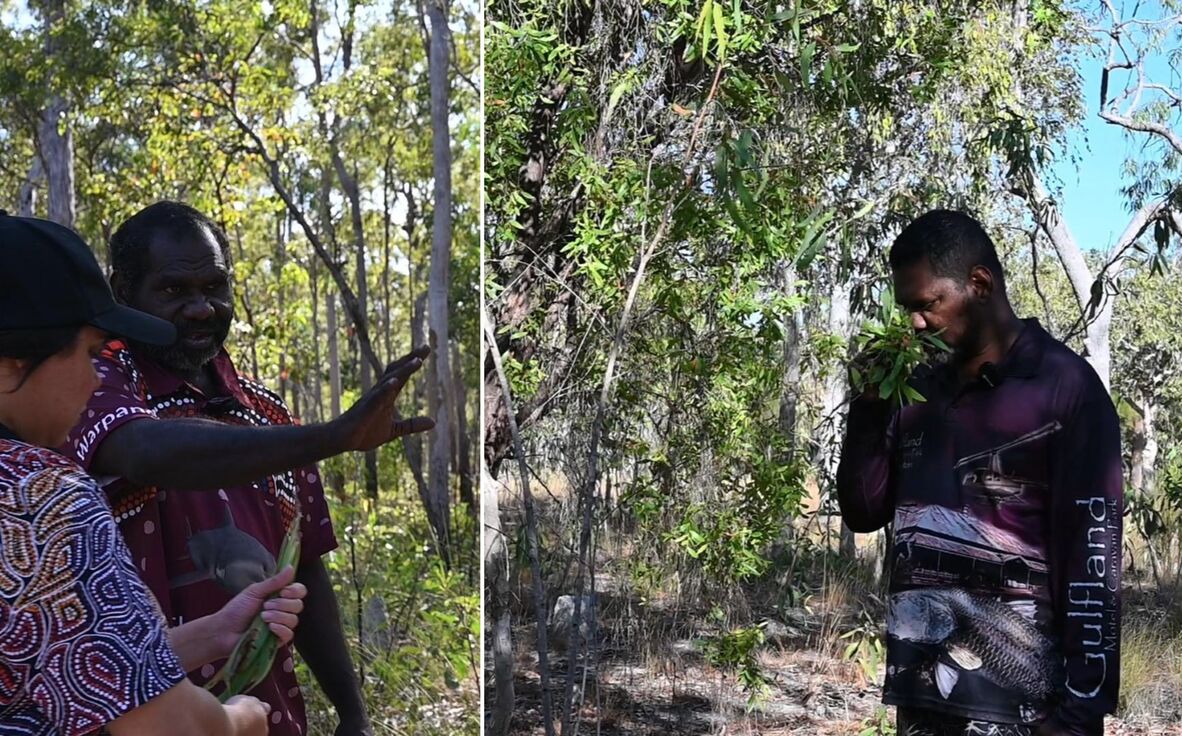
Left: Richard Ornyengai identifying leaves that provide spiritual protection.
Right: Lyal Kawangka identifying tea tree leaves and sharing their practical and culinary uses.
Images: Sheridan Teitzel 2024.
It is well established that pre-colonial notions of health and wellbeing held by Wik peoples differed drastically from those of Europeans. However, existing views on traditional medicine can at times be filtered through a Eurocentric lens, where Western herbal medicine, despite integrating holistic elements, treats plants primarily as external remedies. In contrast, Indigenous plant medicine is embedded within a relational framework, where plants, people, and Country are interconnected through kinship and totemic Dreaming (Edwards, 2005, pp. 83-84). This understanding forms the foundation for Indigenous healing practices, in which health is not solely a biological condition but is influenced by social, cultural, and spiritual factors. Rather than focusing on the pharmacological properties of medicinal plants alone, Indigenous healing traditions incorporate principles of kinship, obligation, and maintaining an overarching balance within society and the environment. While perceptions and value systems have shifted since colonization, plant medicine remains an integral part of everyday life in communities, a concept that will be discussed in greater depth in Blog Three.
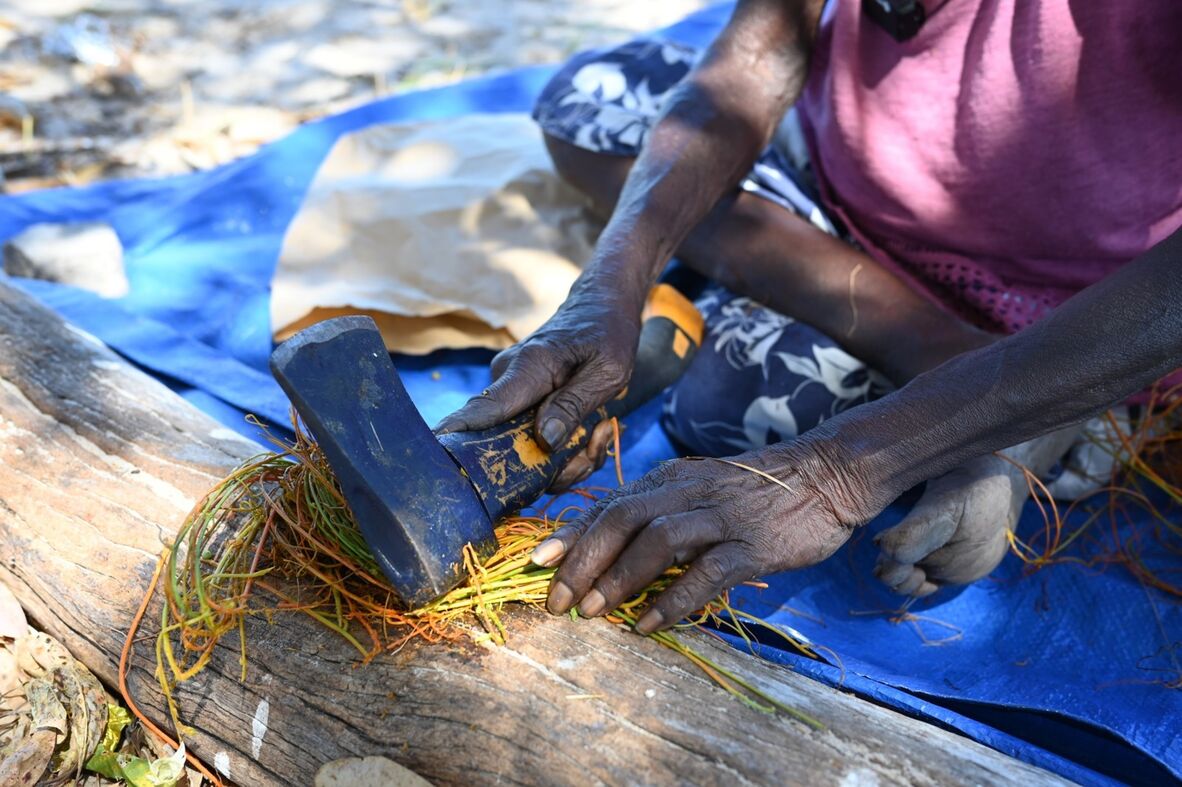
Dorothy Pootchemunka preparing maumaum. Sheridan Teitzel. 2024.
This phase of the project included fieldwork in both Aurukun and Napranum, where both communities identified timtimy (thainakwith) or maumaum (wik-munkan) as the primary medicine still in use today. Unfortunately, the scale by which cultural knowledge has been eroded became evident in comparing the records of Elizabeth Edwards with current practices. Of the 200+ plants captured by Edwards, approximately 12 featured prominently in this project. It is important to note that this project sought to establish a broad framework for Indigenous plant medicine and provide a high-level comparative analysis of traditional and modern perspectives. There remains an opportunity to expand on this research to further recognise the relational nature of health and wellbeing that has persisted in Indigenous communities to this day.
In the Wik consciousness, illness is not and has never been considered a random occurrence but is something linked to environmental factors, kinship obligations and cultural protocols (Edwards, 2005, pp. 159-161). The dualistic and spiritual nature of illness and medicine is still very much evident in the present day, particularly by the Noyan (healers) of Aurukun. These healers are believed to derive their abilities from the totemic Rainbow Serpent (or Taipan). Their knowledge is acquired through transformative initiations involving a type of death and rebirth ritual (Edwards, 2005, p. 157). Research by McKnight (1982) records that their abilities are not infallible to external influences. Certain behaviors, such as excessive consumption of processed food, alcohol, or even frequent sea travel, are believed to diminish their connection to the spiritual realm, thereby reducing their healing capacity (p. 499). The role of sourcery (purri purri) in illness and the Noyan in healing is still an integral part of the collective psyche of Wik & Wik-Way peoples, and this is an important consideration for current health and social policy. The role of the Noyan encapsulates a broader perspective on health and wellbeing, in that if they engage in certain activities, they too become unwell and lose their abilities. They must maintain a certain state of spiritual and physical health to function effectively. It is also believed that payment with money absolves them of their gifts and causes their ‘luck’ to be bought away from them. As such, they currently practice in exchange for food and gifts (Kalkiyorta, personal communication, August, 2024).
It is common practice for not just the Noyan but male family members to remedy spiritual illness through the use of sweat. Edwards (2005) recounts an experience where she fell ill after visiting a story place without following proper protocols, an event understood to be the result of a breach of cultural law. Treatment was administered by a Noyan, who used his underarm sweat and breath to remedy the situation (p. 160). This process essentially forms the basis of a ‘traditional welcome’ whereby the individual is marked as a friend rather than a stranger by the application of sweat/familiar smell, however the full ceremony generally includes a cleansing process to remove any negative spirits the person may be harboring. In addition to acting as an identifying marker through smell, sweat also serves a healing function which is believed to relieve a range of common ailments such as headaches and “belly sore” (Bandcootcha, personal communication, June, 2024).
Ursula McConnell played a significant role in recording information on the Noyan and the cultural knowledge systems of the Wik. In her work, she explains that notions of harmony and balance were determined by an interconnected social, cultural, and religious order, in which all individual clan groups contributed a function towards the whole (McConnel, 1957, Myths of the Munkan, XVI). One example of this connection between the clan groups is reflected in the totemic hero Chivirri, who serves as the primary deity for several distinct traditional owner groups across the Western Cape (Thankupie (2007) pp. 34-35, McConnel (1957) p. 24, Barkley, personal communication, March, 2025). These groups—sometimes referred to as ‘nations’—are composed of individual clan groups, which in turn consist of family groups who interacted with each other in hunting bands, foraging parties, and ceremonial gatherings, functioning as an extended network rather than isolated units (Hale & Sutton, 2021, pp. 29-36). Unfortunately, this system has been significantly impacted following native title and the introduction of mining which has resulted in a breakdown of kinship connections in some circumstances. Historically, this imbalance would have been considered a serious breach of protocol and very likely would require remedy to address the consequences of social breakdown, which in some ways, is perceived as a ‘illness’ in and of itself (Wirrer-George, personal communication, February, 2025). To maintain order, each family group held specific obligations assigned to them by the heroes of creation, now recognized as pulway (totems), which dictated their social, ceremonial, and spiritual responsibilities. This duty is constituted through the Lore which governs all aspects of social, cultural, spiritual, and ceremonial life. As such, Indigenous healing systems cannot be viewed in isolation but must instead be understood through the lens of Lore.
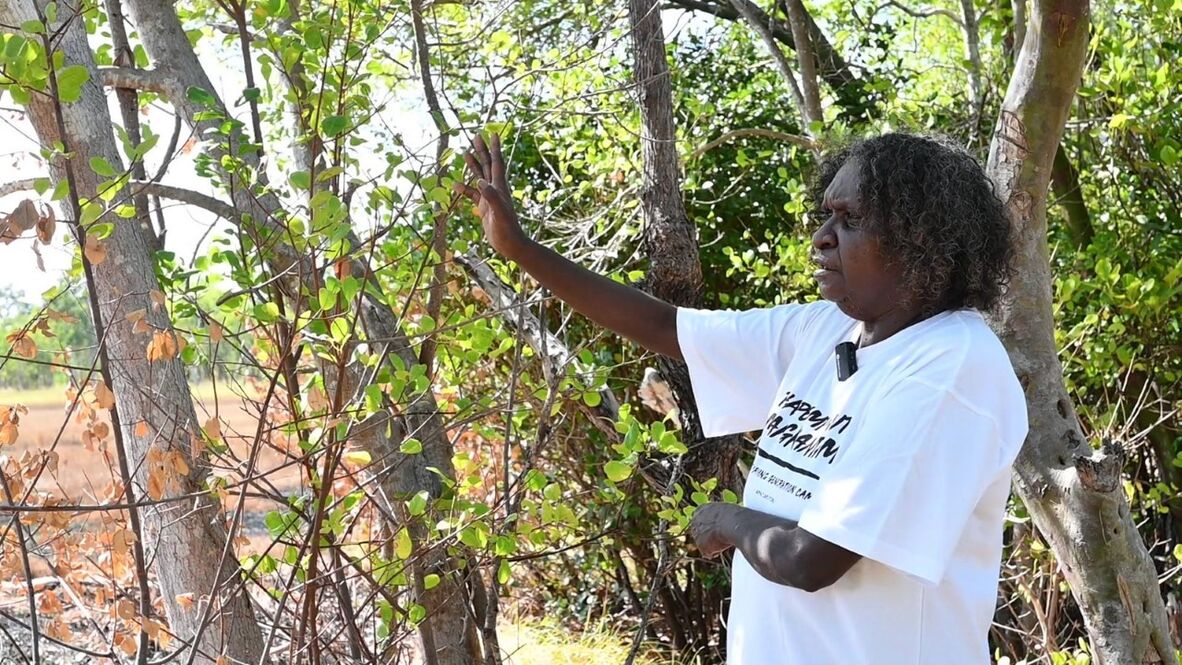
Marie Kalkeevorta identifying Yuk Upan. Sheridan Teitzel 2024.
The relational nature of kinship and country is reflected in the Wik linguistic structure, in which kinship terms rarely carry possessive suffixes. Sutton & Hale (2021) explain that Wik terms for totemic dreaming demonstrates patrilineal ties to country extending back thousands of years. In Liningithi, olay (totem) means ‘father’s father,’ from ‘puul’ (father) and wuut (old man). However, In the Ngathan dialect, ‘kooenhy’ denotes a sibling relationship, extending to ‘minh kooenhy’ (meat sibling, animal totem) and ‘may kooenhy’ (vegetable sibling, plant totem) demonstrating the relational nature of totemic dreaming (p. 27). Within these traditions, medicinal knowledge is not treated as an individual asset but as part of a wider reciprocal system.
Additionally, totemic dreaming is strongly linked to sacred sites, which also play a crucial role in traditional healing practices that extend beyond human illness. Some locations, referred to as ‘poison grounds,’ are believed to possess spiritual dangers and are typically avoided, while others are associated with protection and restoration. Edwards (2005) alludes to an idea that perhaps certain sites, such as waterholes, may harbor dangerous bacteria which in turn has contributed to their identification as a “taboo” or “dangerous” location (Edwards, 2005, p. 160). An example of a healing sacred site is the Agarr Story place at the Gonbung beach in Weipa. The cyclone (Oolay Enor) ceremony was performed here by my late great-grandmother Jean George Awumpun with the use of the theiling plant (pictured) and the Oyol song and dance which is the primary ceremony performed by the Kelinda bloodline.
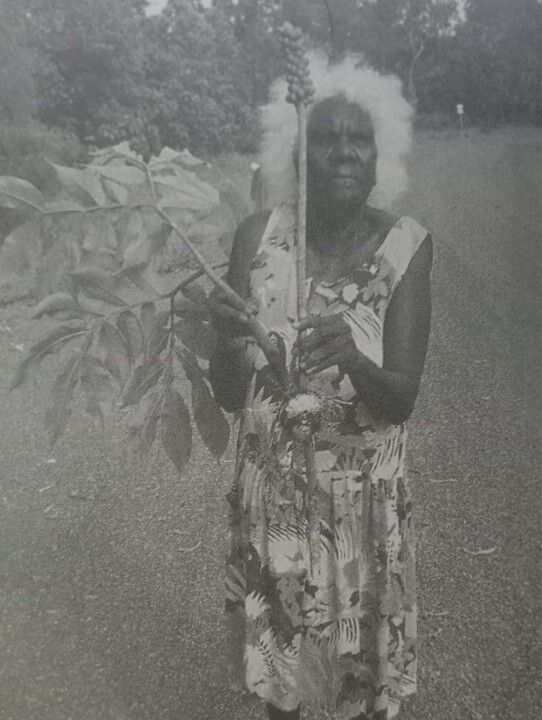
Jean George Theiling n.d. Sheridan Teitzel.
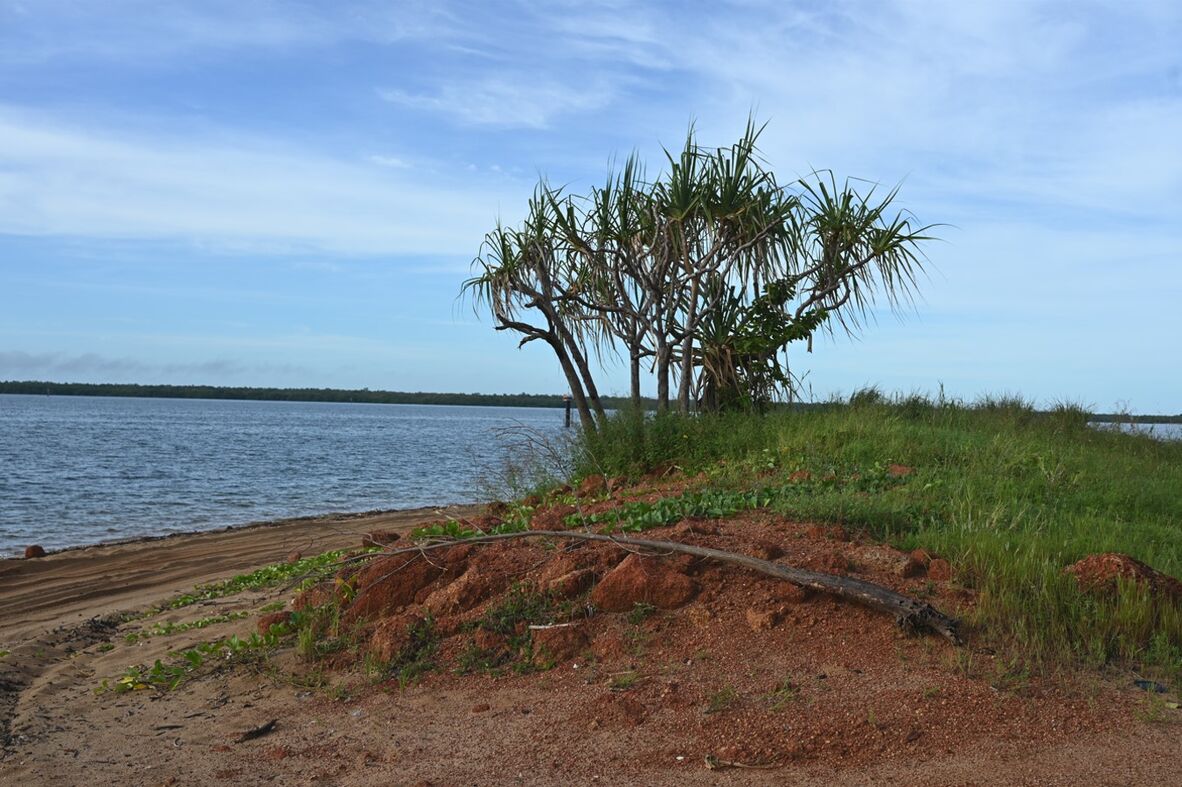
Agarr Story Place, Gonbung Beach, Weipa, Sheridan Teitzel 2025.
Similarily, Agarr (pandanus) is also poison cousin to lightening, and its leaves are used as head or arm bands to repel lightning strikes (Barkley, personal communication, June 2024). This is demonstrated through a dualistic framework in which a poisonous element is referenced to capture and record a healing function. In addition to being poison cousin to cyclone, Agarr is also poison cousin to lightening, and is worn in order to protect the wearer, in this same way, Jurrinjen is worn as a fertility charm to encourage conception, however its seeds are utilised as abortifacient when a pregnancy is unwanted or unsustainable, and Yuk Upan is the poison cousin to the stingray as its milky sap contains the healing remedy to the poison of the stingray bard (Kalkeyorta, Barkley, Ornyengaia, personal communication, 2024)
The access and use of healing plants was subject to protocols relating to totemic dreaming, patrilineal custodianship, closed knowledge systems, and environmental and seasonal factors. The transmission of healing knowledge was historically restricted, with medicinal knowledge specific to certain family groups and locations, passed down within bloodlines and often considered secret. The establishment of the mission era led to changes in this practice, as knowledge once guarded within specific groups began to be shared more widely (Edwards, 2005, p. 261).
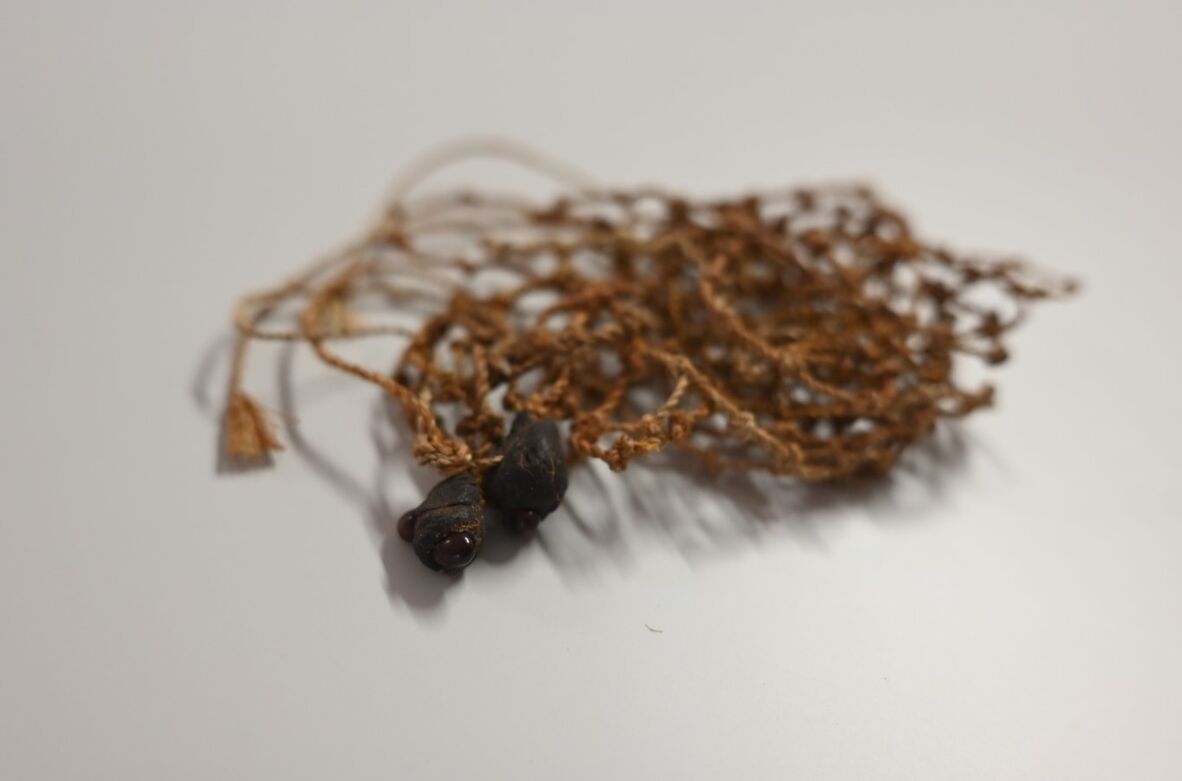
Wik Fertility Charm featuring the Jurrinjen Seed. Circa 1970s. Photograph by Sheridan Tetizel, March 2025.
Historical access to this knowledge was regulated by kinship obligations and certain practices required initiation and mentorship before an individual was permitted to apply certain techniques (Edwards, 2005, p. 169-170). This is likely because healing knowledge was believed to have originated through totemic heroes as a sacred rite, however healing practices were also formed through observation of the environment and passed down through oral traditions, experiential learning, and sensory cues. This transmission incorporates mnemonic and semiotic systems, similar to the Doctrine of Signatures in Western herbalism, where visual and symbolic associations inform medicinal use— the red inner bark of the sea oak is used for red sores, milky sap from the milkwood tree is used to promote lactation, and aromatic leaves are crushed or burned to treat respiratory illnesses (Edwards, 2005, pp. 166-172).
As this research has shown, Indigenous healing is not solely about the pharmacological properties of plants but about sustaining equilibrium—between people, Country, and the unseen forces that connect them. Healing, therefore, is not about treating symptoms in isolation but about restoring balance within an interconnected system of care and obligation. This project proposes that healing knowledge is embedded within a relational framework shaped by five key elements: duality, animism, relationality, custodianship, and environment. Rather than projecting human characteristics onto non-human objects, as in traditional anthropomorphism, the Wik worldview ascribes natural elements to the role of humans, reflecting a relational perception of self and environment. This perspective forms the foundation for understanding and practicing traditional lore, of which healing is just one component.
While cultural knowledge systems and practices have undergone significant transformation since the introduction of missions and subsequent government policies, elements of lore and cultural protocols continue to play a major role in the collective psyche of Western Cape Indigenous communities. Recognising and preserving this knowledge is not just about exploring the past, it is essential for informing culturally appropriate approaches to health, well-being, and policy in remote communities today.
In Blog Three, we will explore how these principles translate into practice and examine the ways traditional healing continues to evolve and adapt in contemporary community contexts.
Sheridan Tietzel
www.arnya.com.au
The Monica Clare Research Fellowship is generously supported by The Siganto Foundation.
Read other blogs by Sheridan Teitzel
- Nature’s Kin: The Integral Role of Kinship in Indigenous Medicine
- Then vs Now: The Changing Landscape of Indigenous Healing
Read more blogs about Queensland's First Nations history by past Monica Clare Research Fellows.
|
|
Category |
Language group |
Region |
Description |
|
Agarr |
Plant |
Alngith Alngith-layngnith/liningithi Thainakwith
|
Mapoon Weipa Region |
Botanical Name: Pandanus
|
|
Alngith |
Clan group |
Alngith |
Weipa Region |
The Alngith are a traditional owner group whose lands encompass the Weipa area. |
|
Alngith/ Layngnith |
Clan group |
Alngith-Layngnith |
Weipa – Robert's Creek |
(Language and Clan Group – Weipa/Roberts Creek) |
|
Enor |
Element |
Alngith |
Weipa Region |
The term for "cyclone," tied to ceremonial knowledge and protection rituals. |
|
Gonbung |
Location |
Algnith |
Weipa |
A culturally significant beach area in the Weipa region associated with sacred stories and ceremonial practices. |
|
Jurrinjen |
Plant |
Alngith Thainakwith |
Weipa Region |
Botanical Name: Abrus Precatorius Common Name: Gidee Gidee
Note: the seeds of the gidee gidee vine are among the most toxic in the world. The potent toxin can enter the bloodstream through skin contact. Traditional preparation requires extensive and highly specific processes and should never be attempted without the proper knowledge and expertise. |
|
Kooeny |
Relational Term |
Ngathan |
Aurukun |
Literally meaning ‘sibling’ in reference to totemic relationships. |
|
Maum maum |
Plant |
Wik Mungkan |
Aurukun
|
Botanical Name: Cassytha Filiformis Common Name: Timothy Fruit or Love Vine |
|
Ngathan |
Language dialect |
Wik-Apalich |
Aurukun
|
(Language Dialect – Wik-Apalich – Aurukun) |
|
Noyan |
Cultural Role |
Wik |
Aurukun
|
Meaning "healing hands," the Noyan are traditional healers within the Wik system who undergo initiation and possess specialized knowledge of medicinal plants, spiritual healing, and ceremonial practices. |
|
Oolay |
Relational Term
|
Alngith |
Weipa Region |
A term meaning "father’s father" in relation to totemic relationships, representing the ancestral lineage and responsibilities tied to one's grandfather. |
|
Oyol |
Song |
Alngith-Layngnith |
Weipa Region |
A ceremonial song performed in cultural practices, particularly within healing ceremonies. |
|
Pulway |
Relational Term
|
Wik Mungkan |
Aurukun
|
Meaning "old man" in Wik-Mungkan, used in reference to a patrilineal ancestor or totemic figure.
|
|
Purri purri |
Magic |
Wik Mungkan |
Aurukun
|
The term for spiritual magic or sorcery, believed to influence health and wellbeing. |
|
Thainakwith |
Clan group |
North of Weipa/Mapoon |
Mapoon |
The Thainakwith people are one of the traditional owner groups associated with the Mapoon and north of Weipa region. |
|
Theiling |
Plant |
Alngith |
Weipa Region
|
Botanical Name: Amorphophallus Common Name: Ground Lily |
|
Timthimy |
Plant |
Thainakwith |
Weipa//Mapoon Region
|
Botanical Name: Cassytha Filiformis Common Name: Timothy Fruit or Love Vine
This plant plays a crucial role in traditional healing. |
|
Wik Mungkan |
Language group |
Wik Mungkan |
Aurukun |
The dominant language spoken in Aurukun, forming part of the broader Wik linguistic and cultural framework. |
|
Wik nations |
Traditional owner groups |
- |
Aurukun
|
A collective term referring to the 5 distinct traditional owner groups within the Aurukun region. |
|
Wik-way |
Traditional owner groups |
Wik Mungkan |
Aurukun Sudley Watson River South of the Embley |
A term assigned to language groups that speak a different or "bad" language from the Aurukun Wik-Mungkan speakers. It refers to several clans from the surrounding regions. |
|
Yuk upan |
Plant |
Wik Mungkan |
Aurukun
|
A plant with specific medicinal applications, known for its connection to traditional healing practices.
Poison cousin to stingray. |
References
Edwards, S. E. (2005). Medical ethnobotany of Wik, Wik-Way and Kugu peoples of Cape York Peninsula, Australia: An integrated collaborative approach to understanding traditional phytotherapeutic knowledge and its applications (Doctoral dissertation). University of London. Retrieved from: https://discovery.ucl.ac.uk/id/eprint/10105289/1/10105153.pdf
Sutton, P., & Hale, K. (2021). Linguistic organisation and native title: The Wik case, Australia. ANU Press. https://doi.org/10.22459/LONT.2021
Mcknight, D. (1982). Conflict, Healing, and Singing in an Australian Aboriginal Community. Anthropos, 77(3/4), 491–508.
Thancoupie. (2007). Thanakupi’s guide to language and culture : a Thaynakwith dictionary / Gloria Fletcher Thancoupie. Jennifer Isaacs Arts & Publishing.
McConnel, U. (1957). Myths of the Munkan / Ursula McConnel. Melbourne University Press.
Sheridan Tetizel's Research Reveals talk.
Comments
Your email address will not be published.
We welcome relevant, respectful comments.